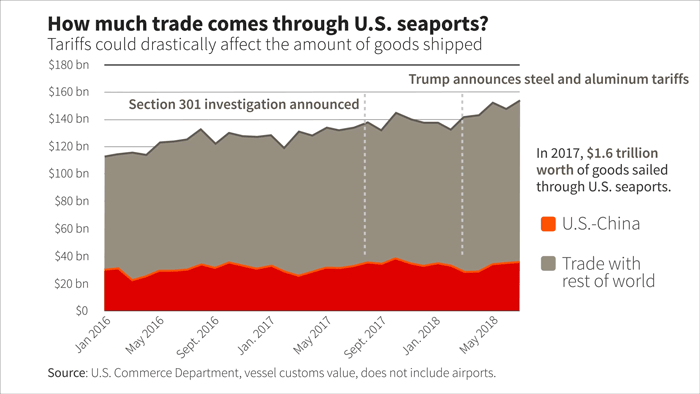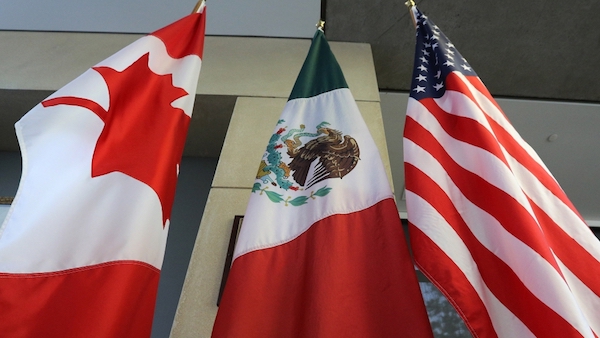Jack Caporal

Around the World in 24 Parts
Fasten your seatbelts and put your tray tables and seat back in the upright and locked position-let’s take a journey through the Boeing supply chain.

Will the Election Results Turn the Tide on Trade?
On November 6, voters flipped the House of Representatives away from Republican control into the hands of Democratic members. Republicans managed to strengthen their grip on the Senate. These developments will have implications for the administration’s trade policy agenda, although some questions remain given the evolving and unconventional political dynamics surrounding the issue.

WTO Reform: The Beginning of the End or the End of the Beginning?
Members of the World Trade Organization (WTO) have become increasingly frustrated with all three of its main functions: monitoring member states’ trade policies, providing a forum to negotiate new trade agreements, and arbitrating trade disputes. In recent months, this has triggered an effort to reform the WTO—what U.S. ambassador to the WTO Dennis Shea termed “the Autumn of WTO reform.”

New Trump Administration’s Trade Negotiations: What’s Next?
The Trump administration has formally notified Congress that it intends to negotiate trade agreements with the European Union, United Kingdom, and Japan. The Scholl Chair explores what the next steps for each party are and where the negotiations could lead.

USMCA, Cars, and National Security Tariffs
Outside of the new U.S.-Mexico-Canada Agreement (USMCA) to replace the North America Free Trade Agreement, the Trump administration negotiated caps on the amount of autos Mexico and Canada can send to the United States before facing potential Section national security 232 tariffs.

From NAFTA to USMCA: What’s New and What’s Next?
After over a year of negotiations and just hours before an October 1 deadline, the Trump administration and government of Canadian Prime Minister Justin Trudeau managed to reach a deal to bring Canada into a new trilateral free trade agreement with Mexico to replace the 25-year-old North American Free Trade Agreement (NAFTA).

U.S.-Japan Trade Talks: What Could They Yield?
After roughly a year and a half of overtures from the Trump administration, Japanese Prime Minister Shinzo Abe has agreed to enter into talks for a “United States-Japan Trade Agreement on goods,” and other key areas. The joint statement announcing the negotiations was released on Sept. 26 on the sidelines of the United Nations General Assembly after a bilateral meeting between President Trump and Prime Minister Shinzo Abe. Questions remain, however, about the scope of the negotiations, the resolution of U.S. national security tariffs on steel, aluminum and automobiles, and what either side may be willing to give to the other to reach a deal.

A New Phase of the U.S.-China Trade War
The Trump administration has opened a new chapter in its trade war with China.

Ports: The Backbone of Global Trade
Seaports are a fundamental part of global trade. In 2017, seaports in the United States handled roughly 42 percent of all trade in goods, worth a total of $1.6 trillion. Ports generate jobs, enable exporters to reach markets overseas, and give consumers access to competitive foreign goods.

Steel and Aluminum Tariffs: A Push and Pull between the President and Congress
President Trump’s decision to impose steel and aluminum tariffs and his threat to put tariffs on automobiles and parts under Section 232 of the Trade Expansion Act of 1962 have generated anxiety on Capitol Hill. Lawmakers have expressed concern about the economic impact of the tariffs as well as the legal foundation for them. Some have suggested reining in the president's tariff authority. What has been proposed, what are the chances meaningful action is taken, and is it a good idea for Congress to take back trade authority from the president?

NAFTA: Milking It for All It’s Worth
President Trump has made it a priority to pry open Canada’s managed dairy market in order to boost U.S. exports of milk, eggs, butter, cheese, and other products north across the border. In response, Canadian Prime Minister Justin Trudeau has pledged to protect the Canadian dairy industry.

The Cost of Leaving Canada Behind
The Trump administration announced that it had reached a bilateral trade agreement in principle Mexico and pledged to move forward with it regardless of whether Canada joins, potentially upending commercial relations with its top trading partner. What would a trade deal without Canada look like by the numbers?

NAFTA or U.S.-Mexico Trade Agreement?
What’s in the U.S.-Mexico agreement and what issues still have to be worked out between the three countries? Is the U.S. headed for a breakup with its northern neighbor or a closer relationship?

U.S.-Turkey trade after steel tariffs
How much trade between the U.S. and Turkey has been impacted by the Trump administration's tariffs and Turkey's retaliation?

The U.S.-China trade fight
President Trump in March announced that his administration would impose tariffs on Chinese imports of that value. So far, China has responded with tariffs on an equivalent amount of U.S. goods. But the U.S.-China trade balance has made it impossible for China to keep up the tit-for-tat tariff exchange.